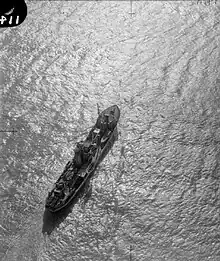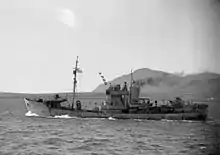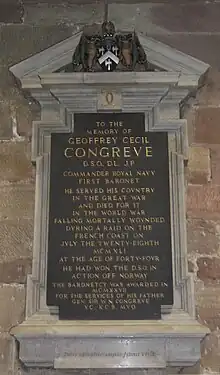Geoffrey Congreve
Sir Geoffrey Cecil Congreve, 1st Baronet, DSO, DL (19 July 1897 – 28 July 1941)[1] was a British Royal Navy officer and landowner. He is known as the commander of a trawler force that took part in the 1940 Namsos campaign. He was killed in 1941 in Operation Chess, a commando raid on France.
Early life
Congreve was the second son of General Sir Walter Congreve and his wife Cecilia Henrietta Dolores La Touche, daughter of Cecil D'Urban La Touche of the Bombay Army.[2] Billy Congreve (1891–1916) was his elder brother.[3]
Congreve was educated at the Royal Naval College, Osborne, from 1911, and the Royal Naval College, Dartmouth.[4][5] In 1915 he was a midshipman on HMS Benbow, and served in the Grand Fleet through the First World War.[4][6] During the period 1919 to 1923, when his father was General Officer Commanding, British Troops in Egypt and Palestine, he was in 1921–2 his aide-de-camp.[4][7]
Walter Congreve died in 1927 as Governor of Malta. The baronetcy intended for him was given that year to Geoffrey, his eldest surviving son, the seat being Congreve, Staffordshire.[7][8] Geoffrey Congreve retired from the navy in 1928, with the rank of lieutenant commander. He farmed an estate of 3,000 acres (1,200 ha)[4]
Second World War
At the outbreak of the Second World War, Congreve became an instructor at the Signals School, HMS Mercury, Portsmouth. He was then given command of four naval trawlers of the Royal Naval Patrol Service, based at Aberdeen and Scapa Flow, among then being HMT Arab. Congreve took command of the force on 22 January 1940, from HMT Aston Villa. After several months of convoy duties and anti-submarine warfare, Congreve received orders on 25 April to cross the North Sea to the coast of Norway, against the German Operation Weserübung. His 16th A/S force comprised the Angle, Arab, Aston Villa and Gaul.[9][10]

The trawlers were under William Boyle, 12th Earl of Cork, commanding the fleet of the allied forces attempting to capture Narvik.[11] The Namsenfjorden area in which they were to operate left the vessels exposed to air attack. Both HMT Aston Villa and HMT Gaul were damaged in attacks, to the point of lacking the seaworthiness to make the return crossing of the North Sea, and were scuttled by their crews.[12] Aston Villa was hit by dive-bombers on 30 April, and scuttled on 3 May in Kroken Bay of Namsenfjorden.[13]
Congreve moved to command of the SS Ranen, a Norwegian passenger steamer converted as a Q-boat, going by the name of HMS Raven; he operated against German forces under Eduard Dietl, moving north from Bodø and cut their telephone cables.[14] On 7 May he was sent with HMT Northern Gem to destroy the oil tanks at Svolvær, with success, and engaged in armed action there.[15]

In June 1940, after returning from the campaign, Congreve was attached to a demolition party sent to Brest, France.[9] He then became an amphibious operations trainer on the west coast of Scotland at Dorlin and Mallaig.[16] Robert Hamilton, an administrator in the Aden Protectorate tasked in August of that year with taking the war across the Red Sea to the Italians then occupying British Somaliland, went to Lochailort for consultation with and instruction from William Stirling and Congreve. The latter found a way of rigging a QF 2-pounder naval gun on a dhow.[17] For a period he was given command of the Jupiter, a Dutch vessel.[13]
On 12 May 1941 Congreve was posted to HMS Quebec, a training establishment in Inverary.[13]
Death

According to Simon Fraser, a friend, Congreve was determined to win a Victoria Cross.[18] He took part as an observer in Operation Claymore on Lofoten in early 1941.[19] He was an observer again for Operation Chess, a raid on the French coast at Ambleteuse by 16 men of No. 12 Commando. He died on 28 July 1941 on a landing craft where he had been ordered to remain, killed by machine gun fire.[13][18]
Awards and honours
On 26 September 1940 it was announced in the London Gazette that Congreve, with rank of commander, had been made a Companion of the Distinguished Service Order (DSO). In the same issue the Distinguished Service Cross was awarded to William Arthur George, skipper of HMT Northern Gem.[20]
Works
The Congreve Family, by Congreve, was printed privately in 1980.[21]
Family
Congreve married Helena Madeline Mary Allhusen in 1922. They had three daughters. He left no heir, and the baronetcy became extinct on his death.[13] His wife remarried in 1942, her second husband being Reginald James Tyler, a retired officer of the Ceylon Police.[22] Of the daughters, Ann Henrietta (born 1923) married in 1944 the architect Richard Tyler, son of Reginald Tyler by his first marriage.[13]
Notes
- "Life story: Geoffrey Cecil Congreve, Lives of the First World War". livesofthefirstworldwar.iwm.org.uk.
- Fox-Davies, Arthur Charles (1929). Armorial Families. Vol. I (7th ed.). London: Hurst & Blackett. p. 416.
- "Life story: Celia Congreve, Lives of the First World War". livesofthefirstworldwar.iwm.org.uk.
- "Congreve, Comdr Sir Geoffrey". Who's Who. A & C Black. (Subscription or UK public library membership required.)
- Miller, Luke (1 January 2022). A Life-Long Springtime: The Life and Teaching of Fr George Congreve SSJE. Sacristy Press. p. 181. ISBN 978-1-78959-198-9.
- Country Life. Country Life, Limited. 1915. p. 646.
- Beckett, Ian F. W. "Congreve, Sir Walter Norris (1862–1927)". Oxford Dictionary of National Biography (online ed.). Oxford University Press. doi:10.1093/ref:odnb/32528. (Subscription or UK public library membership required.)
- "No. 33292". The London Gazette. 8 July 1927. p. 4406.
- "Private Papers of Commander Sir Geoffrey Congreve Bt DSO RN". Imperial War Museums.
- Lassaque, Jean (2003). Guerre navale en Norvège: 8 avril-28 juillet 1940 (in French). Le gerfaut. p. 157. ISBN 978-2-914622-29-5.
- Buchner, Alex (20 November 2020). Narvik: The Struggle of Battle Group Dietl in the Spring of 1940. Casemate. p. 179. ISBN 978-1-61200-918-6.
- "Naval Losses off Norway". Dover Express. 10 May 1940. p. 6.
- Oldfield, Paul (30 August 2016). Victoria Crosses on the Western Front - Somme 1916: 1st July 1916 to 13th November 1916. Pen and Sword Military. pp. 308–309. ISBN 978-1-4738-7457-2.
- Brown, David (5 November 2013). Naval Operations of the Campaign in Norway, April-June 1940. Routledge. p. 122. ISBN 978-1-135-27370-5.
- Grehan, John; Mace, Martin (2015). The Battle for Norway 1940-1942. Barnsley: Pen & Sword Military. pp. 63–64. ISBN 9781783462322.
- Fraser, Simon (31 December 2022). March Past: The Memoir of a Commando Leader, From Lofoten to Dieppe and D-Day. Frontline Books. pp. 252 and note page 255. ISBN 978-1-3990-6860-4.
- Atkin, Malcolm (12 May 2021). Pioneers of Irregular Warfare: Secrets of the Military Intelligence Research Department of the Second World War. Pen and Sword Military. pp. cxliii–cxliv. ISBN 978-1-5267-6601-4.
- Fraser, Simon (31 December 2022). March Past: The Memoir of a Commando Leader, From Lofoten to Dieppe and D-Day. Frontline Books. p. 311. ISBN 978-1-3990-6860-4.
- Buckton, Henry (15 July 2022). Dieppe: A Necessary Failure. Amberley Publishing Limited. p. 19. ISBN 978-1-3981-0387-0.
- "No. 34953". The London Gazette (Supplement). 26 September 1940. p. 5709.
- Robbins, Simon (15 April 2016). British Generalship during the Great War: The Military Career of Sir Henry Horne (1861–1929). Routledge. p. 302. ISBN 978-1-317-17197-3.
- Kelly's (1943). Kelly's Handbook to the Titled, Landed and Official Classes. Kelly's Directories. p. 1808.